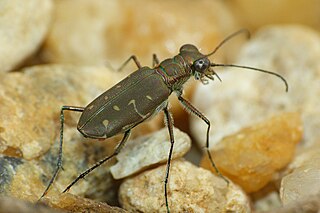
The Bengal tiger is a population of the Panthera tigris tigris subspecies and the nominate tiger subspecies. It ranks among the biggest wild cats alive today. It is considered to belong to the world's charismatic megafauna.

Tiger beetles are a family of beetles, Cicindelidae, known for their aggressive predatory habits and running speed. The fastest known species of tiger beetle, Rivacindela hudsoni, can run at a speed of 9 km/h, or about 125 body lengths per second. As of 2005, about 2,600 species and subspecies were known, with the richest diversity in the Oriental (Indo-Malayan) region, followed by the Neotropics. While historically treated as a subfamily of ground beetles (Carabidae) under the name Cicindelinae, several studies since 2020 indicated that they should be treated as a family, the Cicindelidae, which are a sister group to Carabidae within the Adephaga.

Panna National Park is an Indian national park in Panna and Chhatarpur Districts of Madhya Pradesh with an area of 542.67 km2 (209.53 sq mi). It was declared in 1994 as the twenty second Tiger reserve of India and the fifth in Madhya Pradesh. Panna National Park was given the Award of Excellence in 2007 as the best maintained national park of India by the Ministry of Tourism of India. Although the reserve went through an ordeal losing almost all of its tigers in 2009 to poaching, a subsequent recovery program touted as one of the most successful big cat population restorations, has resulted in a growth of up to 80 tigers within the park.

India is one of the most biodiverse regions and is home to a large variety of wildlife. It is one of the 17 megadiverse countries and includes three of the world's 36 biodiversity hotspots – the Western Ghats, the Eastern Himalayas, and the Indo-Burma hotspot.

Kunwar "Billy" Arjan Singh was an Indian hunter turned conservationist and author. He was the first who tried to reintroduce tigers and leopards from captivity into the wild.

The Dudhwa Tiger Reserve is a protected area in Uttar Pradesh that stretches mainly across the Lakhimpur Kheri and Bahraich districts and comprises the Dudhwa National Park, Kishanpur Wildlife Sanctuary and Katarniaghat Wildlife Sanctuary. It covers an area of 1,284.3 km2 (495.9 sq mi). Three large forested areas are extant within the reserve, although most of the surrounding landscape is agricultural. It shares the north-eastern boundary with Nepal, which is defined to a large extent by the Mohana River. It ranges in altitude from 110 to 185 m, and several streams flow through the reserve from the northwest across the alluvial plain that encompasses the reserve.

Satkosia Tiger Reserve is a tiger reserve located in the border of Angul and Nayagarh district of Odisha, India covering an area of 988.30 km².
Hemendra Singh Panwar is an Indian conservationist and civil servant, known for his efforts in the fields of wildlife and conservation. He was the first director of the Wildlife Institute of India and was the director of Project Tiger. The Government of India honoured him, in 2013, with Padma Bhushan, the third-highest civilian award, for his services to the environment and conservation.

Cicindelini is a tribe of tiger beetles in the family Cicindelidae, containing the overwhelming majority of genera and species in the family. There are more than 90 genera and 2,000 described species in Cicindelini.

Myriochila fastidiosa is a species of tiger beetle found across India and Sri Lanka. The head and pronotum are greenish or coppery and the elytra vary from greenish bronze to coppery. The markings are yellowish. The legs are pale coloured. They are found in open forest and grassland.

Jansenia venus is a species of tiger beetle endemic to the Western Ghats of India. It is found mainly in the summer from May to June inside forest cover. It forages on the ground inside forest but when disturbed it flies and perches on vegetation.

Jansenia dasiodes is a species of tiger beetle endemic to peninsular India. They measure 9.6–10.5 mm (0.38–0.41 in) in body length.

Calochroa hamiltoniana is a species of tiger beetle endemic to the southern Western Ghats of India. It is found only on the shaded floor of dense and moist forests. They are mostly active on the forest floor and fly to low vegetation when disturbed. It is 14 to 17 mm long and has the pronotum and elytra largely greenish or bronze with an orange stripe bordered by black on the inside running along the length of the elytra.

Hypaetha biramosa is a species of tiger beetle found on open sandy beaches in coastal areas across tropical Asia from India to Indonesia.

Calomera fowleri is a species of tiger beetle endemic to peninsular India. It is found foraging on wet sand and riverine areas in the edges of forests. It is somewhat similar to Calomera angulata but that species is found on open sandy beaches, has bolder markings and longer mandibles.

Cicindela goryi is a species of tiger beetle from southern India. It was earlier treated as a subspecies of the closely related Cicindela aurofasciata.

Cylindera collicia is a species of tiger beetle endemic to southern India. About 8 to 9.5 mm long, it is found in forested habitats in the Western Ghats. It is attracted to lights at night.

Cicindela calligramma is a tiger beetle endemic to peninsular India and Sri Lanka. They are 13 to 16 mm long with a green or coppery brown body and three prominent yellowish markings. The ground colour varies a lot. They are found on the ground inside thin forest. They can be confused with Cicindela guttata which has hairs only on the lower part of the cheeks.

Lophyra catena is a species of tiger beetle found in Asia. The species can be confused with the similar looking Lophyra cancellata and Lophyra histrio but can be differentiated by the presence of a dense patch of hair on the cheek.


















